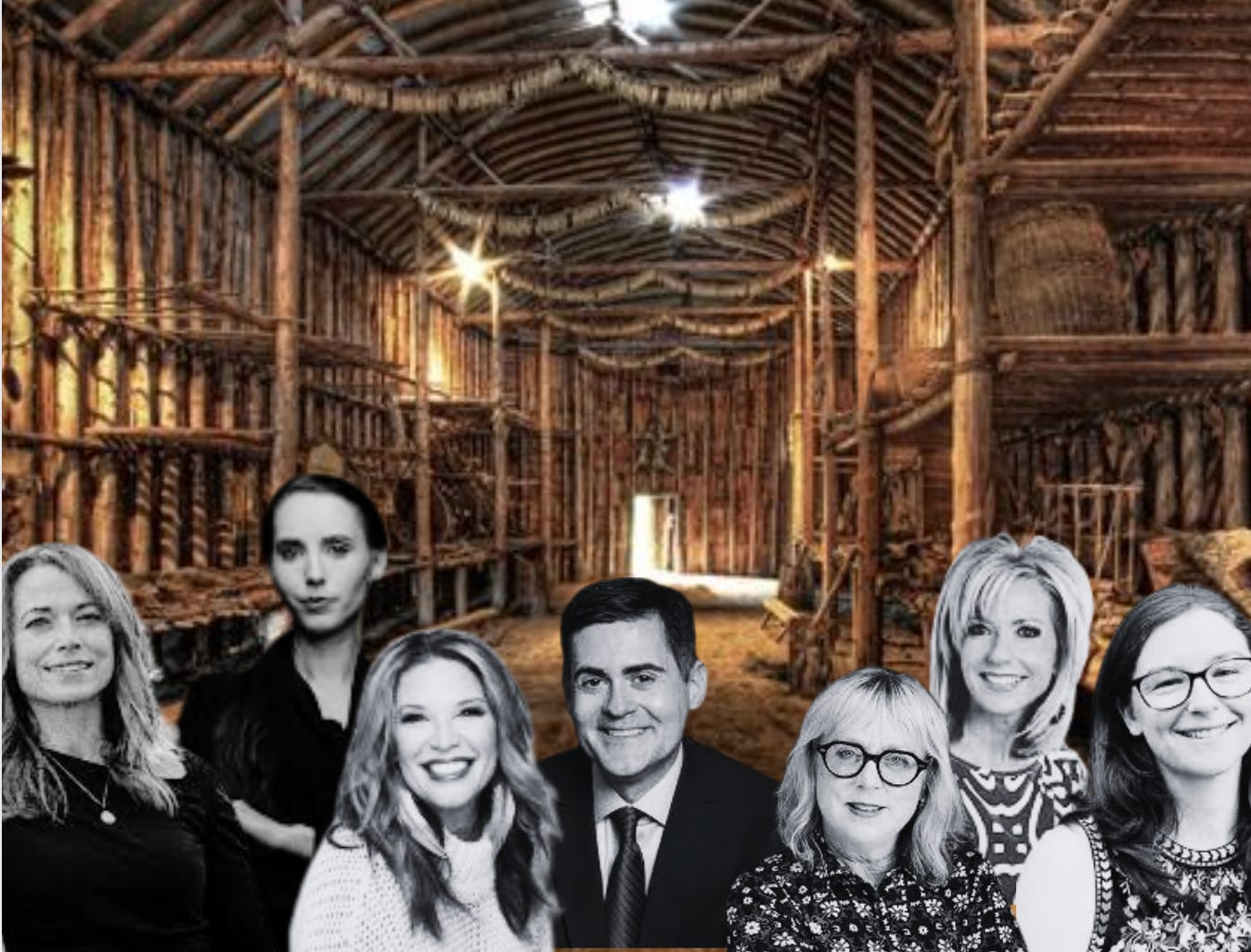You might have heard the term ‘Longhouse’ used in social media in recent days or months, and been bewildered by the term. Those who use it, tend to use it in a way that presumes everyone else is familiar with its meaning. But if you fancy yourself a foot soldier in the culture wars, this is definitely a term you should recognize and understand. And furthermore, it’s a term you might find very helpful.
THE RIGHT WORD MATTERS
In the crucible of human debate, words are the raw elements, molten and malleable, awaiting the right word to transmute thought into understanding. Argumentation is their forge, where ideas bubble and clash, and a single, deftly chosen word acts as the catalyst—igniting clarity from the embers of confusion.
The potency of that perfect word lies in its alchemical purity, a distilled essence that refines the chaos of discourse into something structured and sensical. Like a philosopher’s stone, the right word transforms the base metal of vague notions into a good argument, its weight undeniable, its edges sharp.
Yet, the true alchemy of words unfolds in their union, a careful blend that tempers each syllable into a greater whole. To pluck the exact phrase from the ether is to wield the art of the adept. An argument’s fate hinges on this craft, where the labor of selection separates fleeting ash from enduring treasure.
In short, the right term - properly understood - can make all the difference in the world. And the term “Longhouse” is that right word.
THE LONGHOUSE
Far removed from its original anthropological meaning—a communal dwelling used by various indigenous peoples across the globe—it has been repurposed as a metaphorical critique of modern social order, often with a specific focus on gender dynamics, power structures, and cultural norms.
To understand the modern use of "the Longhouse," we need to understand its historical and anthropological origins. A longhouse is traditionally a type of elongated, communal dwelling found in various cultures worldwide, from the Iroquois of North America to the Dayak peoples of Borneo and the Neolithic farmers of Europe. These structures were typically constructed from wood and bark or other local materials, designed to house multiple families—often related through kinship ties—under a single roof. Among the Iroquois, for instance, longhouses were not just homes but cultural and political hubs, reflecting a matrilineal social structure where descent and inheritance passed through the mother’s line. The longhouse symbolized unity, community, and shared responsibility, yet it also entailed a lack of privacy and a collective existence governed by strict social norms.
This historical backdrop provides the foundation for the term’s modern adaptation. The communal nature of the longhouse, its association with matriarchal tendencies in those cultures, and the perceived constraints on individual freedom within such a structure have been seized upon by conservative and biblical thinkers to draw parallels with today’s matriarchal society.
In its current usage, "the Longhouse" has been transformed into a symbol of an overbearing, feminized social order that dominates Western culture. The concept was notably fleshed out in a 2023 article in First Things, titled "What Is the Longhouse?", which crystallized its meaning for a broader audience.
At its core, the Longhouse metaphor critiques an "overcorrection" in modern society toward norms and values deemed feminine. These include an emphasis on emotional safety, consensus-driven decision-making, indirect methods of control (such as social ostracism or reputational harm), and a rejection of overt ambition or competition—traits often associated stereotypically with masculinity. These things - none of which are conductive to societal flourishing, have been driven by feminist advances, the rise of progressive ideologies, and the increasing influence of women in institutions like education (where they earn over 57% of U.S. bachelor’s degrees) and professional management (where they hold 52% of roles). The result is a cultural landscape that mirrors the communal, privacy-scarce, and conformity-enforcing environment of a historical longhouse, but now scaled up to encompass entire societies.
The "Den Mother" is a central figure in this metaphor—an archetype of the matriarchal authority who rules the Longhouse. She enforces taboos, polices speech, and prioritizes group harmony over individual liberty. In this narrative, phenomena like cancel culture, corporate HR policies, and "safetyism" (a term describing the obsession with protecting people from emotional harm) are evidence of the Longhouse’s grip. The term is shorthand for a social order that stifles masculine virtues—independence, risk-taking, and hierarchy—in favor of a nurturing but suffocating collectivism.
The Longhouse metaphor is deeply tied to debates about gender and power. It argues that the rise of women in public life—coupled with cultural shifts like the #MeToo movement and DEI initiatives—has tilted society toward a gynocentric model that disadvantages men. Certain statistics, like women’s dominance in higher education and the prevalence of female-led HR departments, is proof of a matriarchal takeover. The Longhouse, in this view, distrusts male ambition and competition, labeling them "toxic" or "patriarchal," and replaces them with a softer, more inclusive ethos that prioritizes feelings over merit.
Beyond gender, the Longhouse speaks to a broader anxiety about social order itself. It evokes a sense of lost autonomy, where individuals feel trapped in a system that demands conformity and punishes dissent. This resonates with historical critiques of collectivism, from Hobbes’s Leviathan to Orwell’s 1984, but recasts them in a gendered light. Whether it’s the "nagging Den Mother" or the faceless bureaucracy of woke institutions, the Longhouse represents a social equilibrium that is stiflingly stable—maintained not by force but by shame, guilt, and the ever-present threat of exclusion.
Ultimately, "the Longhouse" is a Rorschach test for our cultural moment. It’s a term that encapsulates fears of overreach—whether by women, progressives, or faceless institutions—and a longing for a world where individual freedom trumps collective comfort. It draws on the historical longhouse’s communal constraints to critique a modern society seen as too safe, too soft, and too controlled.
THE EVANGELICAL LONGHOUSE
Figures like Beth Moore or Joyce Meyer, with their vast followings and polished platforms, wield influence that rivals any megachurch pastor, yet their approach mirrors the Longhouse’s ethos. They emphasize emotional resonance, relational harmony, and a nurturing tone—qualities that align with the justifiable critique of a feminized culture where individual boldness gets softened under the weight of collective care. Their ministries, built on Bible studies and conferences that pack arenas with women seeking sisterhood, often prioritize healing over confrontation, subtly reinforcing a dynamic where dissent is smoothed over rather than sharpened. And more times than not, the fact that what they offer is doctrinal hot garbage, is overlooked or altogether unnoticed by the women enjoying the sisterhood.
Their nods to male headship - if given at all - are insincere and immaterial. For them, it’s a delicate balance of fake submission and real sway. Many, like Moore, give a subtle nod to male headship while carving out space as "teachers" or "speakers" rather than pastors (until, once building an empire of their own, inevitably always end up promoting female pastors). This sidestep keeps them palatable to traditionalists but also mirrors the Longhouse’s indirect power plays: influence wielded through suggestion, not decree. Their message perpetuates a system where the "Den Mother" rules by fostering dependence rather than defiance. It’s not about Biblical doctrine or objective reality; it’s about how they feel.
But even in theological circles in which Beth Moore or Jen Hatmaker would be rejected on doctrinal grounds, women still rule the roost and set the evangelical agenda. Even the “stalwart conservatives” rolled over to Rachael Denhollander’s #ChurchToo Inquisition and countenanced her accusations despite the fact that the majority of those accusations ran directly contrary to the Biblical ethics of how accusations should be - or not be - taken into consideration. And thanks to the men who allowed women to set the Southern Baptist agenda, it has cost the SBC millions of dollars, likely millions of members (by the end of the day), and possibly will bankrupt the SBC financially as much as women bankrupted the SBC theologically.
It’s hard not to notice the Longhouse in evangelicalism. As I pointed out on X last month, the photo of Russell Moore with his Christianity Today staff looked eerily similar to the photo of Russell Moore with his ERLC staff; there was Russell Moore, a solitary token male of a minority ethnicity, and rooms chock-full of white girls. And as I pointed out yesterday on X, Moore’s fanbase to this very day is easily 90-95% female. For whatever reason they’re drawn to figures like Russell Moore, perhaps because he appears asexual and non-threatening, much like the way suburban wine moms want a gay best friend as a status symbol, I’m not sure. But I’m positive that his feminized, empathy-fueled theology has at least something to do with it.
So many female evangelical leaders we now regret - Amy Byrd, for example - were DEI hires of what were then conservative evangelical men. They were brought onto ministry platforms with a degree of careless but convenient thought. The idea, which them seemed like a good one, was that women would benefit more from stimulating theological discussions with a female voice that could occasionally chime in. But in the end, what little credence Byrd was given went to her head, she became a raging feminist, and dragged her male colleagues leftward with her. This is the repeated pattern of what transpires when otherwise sound teachers become convinced that women - for some odd reason - would benefit more from female teachers. The notion, which then appeared common place and common sense, has been shown to have been a fantastically bad idea with seriously negative consequences.
Even the great majority of women who have taken upon themselves discernment ministry - and I’ll cite Christine Pack of Sola Sisters or Erin Harding as an example - end up going off the reservation. With a little attention, even perceived authority has the tendency to lead them to very surprising (and wrong-headed) destinations. Even the “good ones” like Michelle Lesley have made some terrible positional judgments (like siding wrongly, at first, on Karen Swallow Prior) on matters that were obvious to most men. Other good ones, like Amy Spreeman, seem largely to take positions based upon their personal affinity for whatever male discernment minster they’re clinging to at the moment. Others who have shown good judgment down the line - like Diane Gaskins (formerly of Pulpit & Pen) soon break under the pressure of controversy and are not long for the work.
Perhaps God - in his infinite wisdom - created gender roles not only to establish a semblance of order (as some argue) but because men and women are uniquely and differently gifted. And this has been the creep of Gynocracy into Biblical Patriarchy, at which point they made the bastard child of Complementarianism; it is the idea that the division of gender roles is only because of God is Obsessive-Compulsive and likes things neatly organized. Largely, mainstream “Complementarianism” has come to affirm that women really could do the job men could do, buthttps://insighttoincite.substack.com/about virtuously submissive because God likes a neat arrangement of things.
This is how you get - as Protestia recently reported - a Southern Baptist Church without female pastors on staff (thereby remaining in ‘friendly cooperation’ with the SBC), but with women both preaching to men and administering Communion. You get to that point by believing the lie that women are equally as equipped, and so long as we don’t pass out pastoral titles, God’s order remains magically in place.
But in the Longhouse, women don’t have to be officially in charge, to be unofficially in charge. It’s common knowledge in the business world, for example, that the secretaries and personal assistants often have power equal to the boss or CEO. And whatever you do, you don’t get on the wrong side of the woman at the front desk; it’s likely she could put your head on a platter. Most female control goes unspoken, but understood. It may not be official power, but it is power nonetheless.
We’ve all met pastors who preach Complementarian theology, and whose wives dutifully submit when in the church house, but who berate their husbands at home and rule over them. I’ve often chuckled at this common malady, because pastor’s wives end up ruling over the congregation, but through their husband as a male intermediary. It defeats the purpose of the command, obeying the letter of the law but profaning its spirit.
In recent weeks, evangelicals have discussed the danger of empathy, or at least the danger of presuming that empathy is a virtue and not a handicap. What has largely gone unsaid in these important discussions is that the popularization of empathy in evangelical circles - as some kind of criterion, benchmark, or standard by which all things should be judged - is the direct result of the matriarchal Longhouse. Empathy is a feminine invention; not a masculine one.
And as I’m sure you’re aware, I blame the sorry condition of evangelicalism today on the lack of polemical work within the church over the last 15 years, and the blacklisting of discernment. It’s not been lost on me that’s a purely feminine contribution. The feminine influence, for example, tolerates Jonathan Merritt using his evangelical credentials for years to rebuke conservative Christians. The masculine influence is more inclined to ask why we’re being lectured by a sodomite, and move on with our business. The feminine influence is eager to hear-out Sam Allberry on his thoughts about marriage. The masculine influence is eager to reject the opinion of a homosexual on heterosexual marriage. In short, the feminine influence makes nice with God’s enemies in an attempt to softly lead them by the hand from error. The masculine influence is eager to skin the wolf and hang it over the fence as a warning.
WHAT A REDESIGN OF EVANGELICALISM REQUIRES
Evangelicalism stands at a crossroads, its engine sputtering under the weight of a culture that’s outgrown its old gears. The need to redesign it isn’t just about patching leaks—it’s about scrapping the blueprint that’s been hijacked by the feminist Longhouse, that smothering setup where safety, feelings, and groupthink reign. To break free, the movement has to ditch the soft edges and reclaim a raw, unapologetic core—less about soothing souls in a cozy huddle and more about forging them in a fire of truth and grit. Think less coffee-klatch Bible studies and more open-field reckonings, where the focus isn’t on coddling but on confronting, not on harmony but on hard-won clarity.
This redesign means sidelining the Longhouse’s playbook—no more indirect sway or emotional babysitting as the main gig. Instead, evangelicalism could lean into a framework that prizes bold reasoning and individual wrestling over collective vibes. Picture leaders who don’t just preach to the choir but challenge it—pushing back against the impulse to pad every sermon with relational fluff or shrink from the sharp edges of doctrine. It’s not about kicking women out of the mix; it’s about ditching the stereotype that influence has to wear a nurturing mask. A retooled evangelicalism could trade the Den Mother’s apron for a prophet’s mantle, aiming to stir the pot rather than simmer in it, and letting the chips fall where they may without the Longhouse’s velvet glove to catch them.
If you appreciate my work, consider grabbing a paid subscription for $8 a month or $80 a year to access exclusive content (like all the articles behind the paywall, access to our weekly Zoom round table, and more).
If you don’t want a subscription, please consider a one-time gift of your choosing by clicking the ‘coffee link’ below. This is one of the things I do to provide for my small farm and big family, so I sure appreciate it.


















Share this post